Mechanical Trees and Mini-Woolly Mammoths: May-June Print Science Fiction Magazines
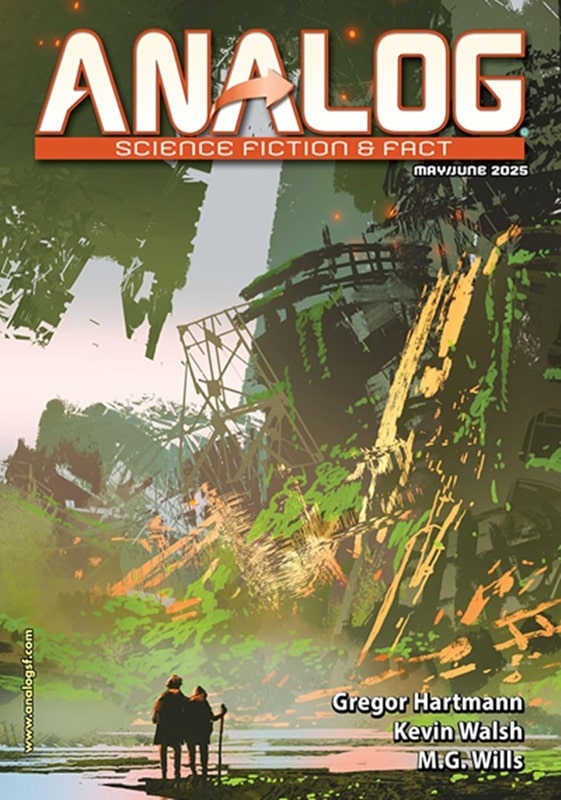 |
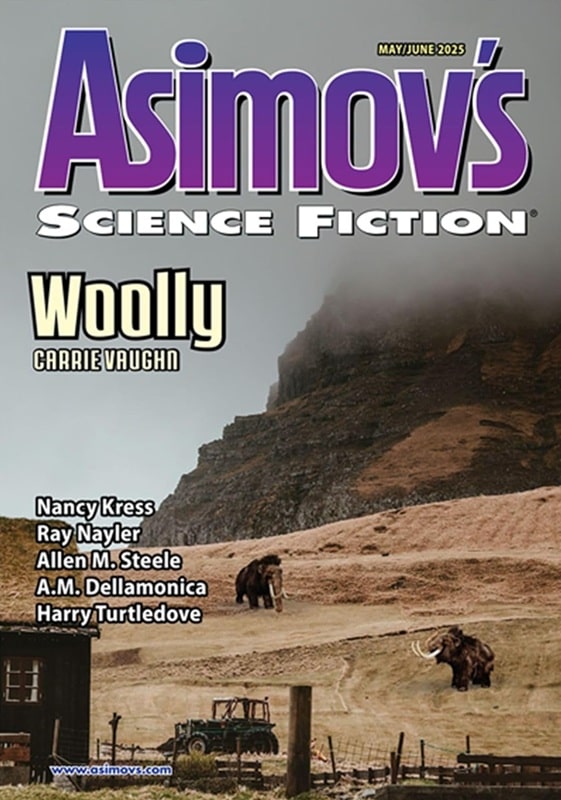 |
May-June 2025 issues of Analog Science Fiction & Fact and Asimov’s Science
Fiction. Cover art by Tithi Luadthong/Shutterstock, and IG Digital Arts & Annie Spratt
Back in February I was surprised to learn that the last surviving print science fiction magazines, Analog, Asimov’s Science Fiction, and The Magazine of Fantasy & Science Fiction, had all been sold to Must Read Books, a new publisher backed by a small group of genre fiction fans. I was very sad to see Analog & Asimov’s leave the safe harbor of Penny Press, where they’ve both sheltered safely for very nearly three decades as the magazine publishing biz underwent upheaval after upheaval.
But I was nonetheless cautiously optimistic. The magazines couldn’t continue to survive as they were, with 25+ years of slowly declining circulation — and indeed F&SF, while it claims to be an ongoing concern, has not published a new issue in nearly a year.
But after four months, that optimism is rapidly fading. The first issues from Must Read, the May-June Analog and Asimov’s, technically on sale April 8 – June 8, have yet to appear on the shelves at any of my local bookstores, and there’s been no word at all at when we can expect the July-August issues, scheduled to go on sale today. And there’s no whisper of when we might expect to see a new issue of F&SF at all.
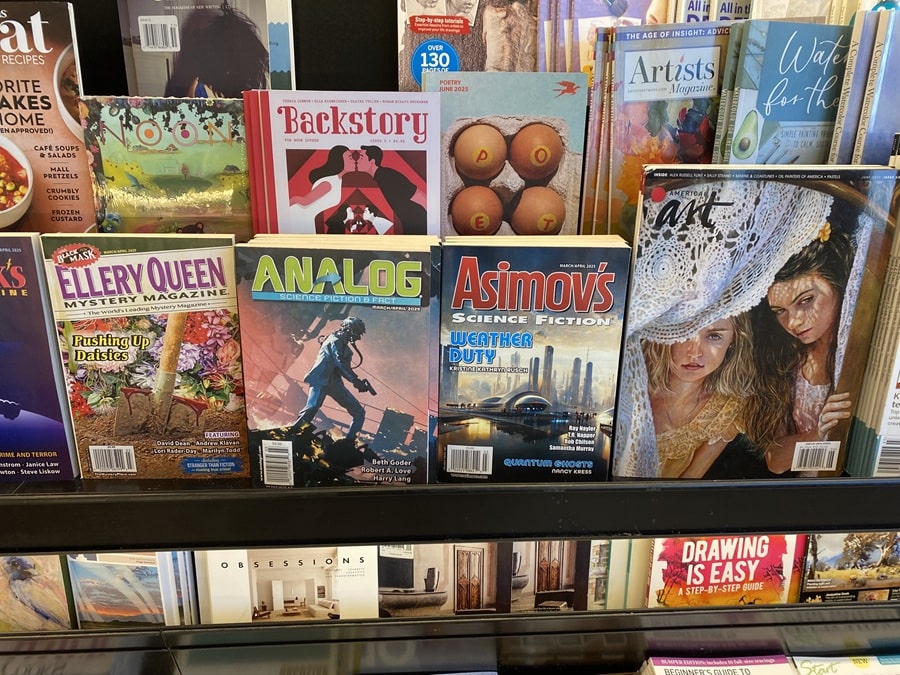
So why are there photos of the May-June issues at the top of this column? Are they ChatGPT hallucinations?
Nope. If you have a digital subscription, your issues of Analog and Asimov’s arrived on time on April 8. And I’m told that folks with print subscriptions received hard copies in the mail around May 15. So copies do, in fact, exist. But the new owners don’t seem to have the myriad complexities of distribution figured out yet.
A shame, since I’d love to get my hands on the latest issues (after having my copies mangled by the post office in the 80s, I switched to buying them from bookstores, and have stuck with that method for the last 40 years). They’re just as enticing as usual, with contributions from Nancy Kress, Allen M. Steele, Ray Nayler, Harry Turtledove, Steve Rasnic Tem, Carrie Vaughn, A.M. Dellamonica, Brenda Cooper, Shane Tourtellotte, Mark W. Tiedemann, Gregor Hartmann, Howard V. Hendrix, and many more.
Mina at Tangent Online enjoyed the latest Asimov’s.
“The Hunt for Lemuria 7” by Allen M. Steele is a sequel to “Lemuria 7 Is Missing” [from the July/August 2023 issue]. The story is a mosaic of various sources piecing together the efforts to find the missing crew of six like a lunar Mary/Marie Celeste. Merlin Feng is determined to find out what happened to his mentor and his mentor’s daughter and former girlfriend, Amelia. He designs robotic rovers with advanced AI systems to investigate the site of their disappearance and other sites where Transient Lunar Phenomena have been observed. Five years after the disappearance, Amelia turns up at the Great Wall of China. All she can say is that she has been sent back to warn others not to set foot on the moon…
“In the Forest of Mechanical Trees” by Steve Rasnic Tem is a thoughtful and thought-provoking story about a world living with climate change and other environmental ravages. An elderly couple run a theme park in the ever-growing Arizona desert. The park includes trees that soak up carbon dioxide and sculptures to commemorate the growing list of extinct species. The park’s staff are determined in their fight against the elements and it’s curiously not a depressing story. But it is a sobering reminder of the direction humanity is heading in.
“The Fight Goes On” by Harry Turtledove imagines a Sarajevo in 1914 filled with time travellers: some trying to stop the murder of Franz Ferdinand; some trying to ensure it happens. We follow the attempts of one time traveller. It was well-written and amusing but didn’t grab me.
In “The Tin Man’s Ghost” by Ray Nayler, we meet Sylvia Aldstatt again: the agent who can speak with the dead with the help of alien technology. We are in the McCarthy era but in a world changed by the use of technology reverse engineered from a crashed flying saucer. Sylvia’s mission this time is to talk to the ghost of a robot (also referred to as a war machine or the Tin Man by others, as a “mechanical” by itself). Sylvia discovers that all mechanicals were given the memories of one man, Alvin Greenly, but that they diverged over time. And she discovers that mechanicals are capable of courage and sacrifice. Sylvia also meets Oppenheimer but that is not the main focus of the story; the main focus is on stopping, or at least slowing down, the development of the atomic bomb. The mechanical, Bill, worms its way into our hearts, giving the last line of the story its full poignancy… an excellent novelette.
“Trial by Harry” by Michael Libling is ultimately a horror story. A new drug is on trial for older people in a vegetative state. Harry is visited faithfully by his two surviving children as he slowly comes back up from the bottom of a deep well. We see his memories as he recovers them and slowly we realise that Harry was not a good man. The title takes on a chilling double meaning as you reach the end of the story.
“Woolly” by Carrie Vaughn is a warm tale. Joy runs a rescue farm for abandoned, genetically modified, mini-woolly mammoths. When the government decides to put them all down, Joy needs to win more time to fight the decision in court. The tale ends on a light note, with the reader rooting for Joy and her charges.
Read Mina’s complete review here.
The new Analog is reviewed by the always reliable Victoria Silverwolf at Tangent Online. Here’s a sample.
“Isolate” by Tom R. Pike takes place in a galactic empire ruled by a monarch who is worshipped as a deity. The protagonist is a cleric and a linguist, sent to a remote region of a planet recently annexed to the empire. Her task is to determine if the local language is related to the empire’s official language, and thus acceptable, or if it must be eliminated…
In “The Robot and the Winding Woods” by Brenda Cooper, an elderly couple maintains a campground, even though there have been no visitors for many years. A robot arrives to tell them that the area is to be returned to pure wilderness, and that they must leave. Another fact revealed by the robot changes the situation…
“Mnemonomie” by Mark W. Tiedemann takes place in a society where boys become men by having their memories completely replaced, instantly changing them from adolescents interested in aggressive sports to adults with careers. One such young man suffers brain injury during an attack by a rival team, so the process is not completely successful, leaving him with memories of his past. In this way, he learns something about the world in which he lives…
“The Scientist’s Book of the Dead” by Gregor Hartmann takes place years after a devastating war wiped out most of humanity and a revolution resulted in a world ruled by technocrats. The western hemisphere is completely depopulated and left as a wilderness area. The aging leader of the revolution and his chief of staff, a young woman bred to be at the peak of human ability, lead the narrator and other technocrats on a hike in an otherwise deserted North America… The story offers much food for thought, without easy answers.
The two characters in “Siegfried Howls Against the Void” by Erik Johnson are sentient starships, many lightyears apart in their separate voyages. Over millennia, they send occasional messages to each other. One of them, identified as male, comes to depend on the signals from the other, identified as female. In addition to making the starships seem like people, the author also anthropomorphizes stars and planets, describing them as mothers and their children. Despite having no human characters, this is a romantic story, with interstellar exploration as a source of emotional wonder and despair… This is the author’s first published story, and it reveals a rich imagination and a lush narrative style that could benefit from a little discipline.
The novella “Bluebeard’s Womb” by M. G. Wills deals with a project to create a uterus within a man’s body, which can then have an embryo implanted in it so the man can give birth by Caesarean section. The first volunteer is an acquaintance of the woman in charge. He has his own agenda, which only becomes clear after the child is born. Although this is not the first story to feature male pregnancy, it is unusually realistic and scientifically plausible… this provocative work is sure to create controversy. Readers’ opinions on the issues raised in it will determine how they react to it.
Read Victoria’s full review here.
Here’s all the details on the latest SF print mags.
[Click the images for bigger versions.]
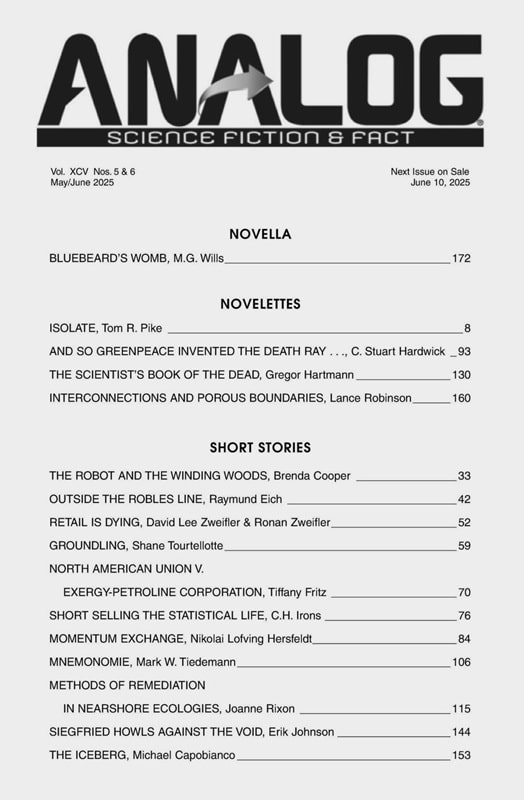 |
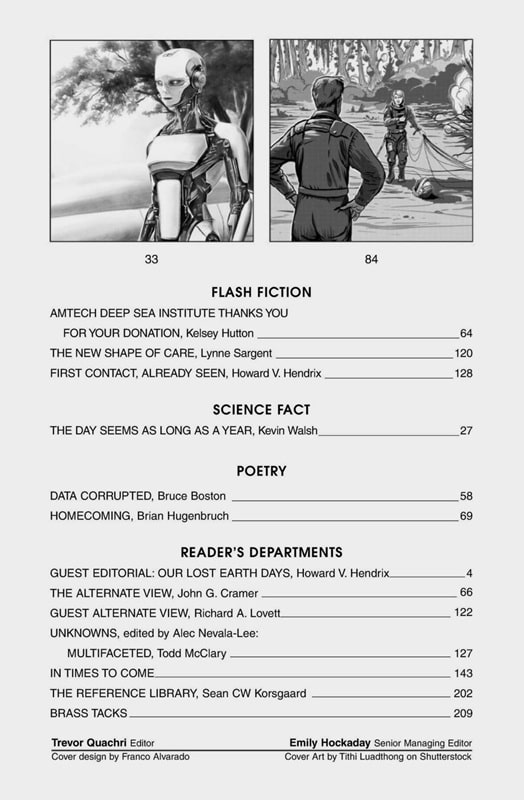 |
Analog Science Fiction & Science Fact, May-June 2025 contents
Analog Science Fiction & Science Fact
Editor Trevor Quachri gives us a tantalizing summary of the current issue online, as usual.
Unlike this issue, there’s no grand unifying theme for May/June other than “good stories,” but that’s okay: it’ll keep you on your toes!
First up is a bit of classic Schmidtian linguistic science fiction in “Isolate” by Tom R. Pike. We also anchor the issue with what’s likely to be the definitive hard SF take on a classic SFnal “What If . . . ?” scenario, in “Bluebeard’s Womb,” by M.G. Wills, plus a bunch of other fine fiction, including a game of cat and mouse between a jailer and his prisoner, only on a grand scale, in “Momentum Exchange,” by Nikolai Lofving Hersfeldt; an older couple trying to make it in a world that no longer has room for them in a very concrete way in “The Robot and The Winding Woods,” by Brenda Cooper, plus much, much more, from folks like C. Stuart Hardwick, Kelsey Hutton, Michael Capobianco, and Gregor Hartmann.
Here’s the full TOC.
Novella
“Bluebeard Womb” by M.G. Wills
Novelettes
“Isolate” by Tom R. Pike
“And So Greenpeace Invented the Death Ray…” by C. Stuart Hardwick
“The Scientist’s Book of the Dead” by Gregor Hartmann
“Interconnections and Porous Boundaries” by Lance Robinson
Short Stories
“The Robot and the Winding Woods” by Brenda Cooper
“Outside of the Robles Line” by Raymund Eich
“Retail is Dying” by David Lee Zweifler & Ronan Zweifler
“Groundling” by Shane Tourtellotte
“North American Union V. Exergy-Petroline Corporation” by Tiffany Fritz
“Short Selling the Statistical Life” by C.H. Irons
“Momentum Exchange” by Nikolai Lofving Hersfeldt
“Mnemonomie” by Mark W. Tiedemann
“Methods of Remediation in Nearshore Ecologies” by Joanne Rixon
“Siegfried Howls Against the Void” by Erik Johnson
“The Iceberg” by Michael Capobianco
Flash Fiction
“Amtech Deep Sea Institute Thanks You For Your Donation” by Kelsey Hutton
“The Shape of Care” by Lynne Sargent
First Contact, Already Seen” by Howard V. Hendrix
Science Fact
The Day Seems as Long as a Year, by Kevin Walsh
Poetry
“Data Corrupted” by Bruce Boston (Poetry)
“Homecoming” by Brian Hugenbruch (Poetry)
Reader’s Departments
Guest Editorial: Our Lost Earth Days by Howard V. Hendrix
The Alternative View, John G. Cramer
Guest Alternative View by Richard A. Lovett
In Times to Come
The Reference Library by Sean CW Korsgaard
Brass Tacks
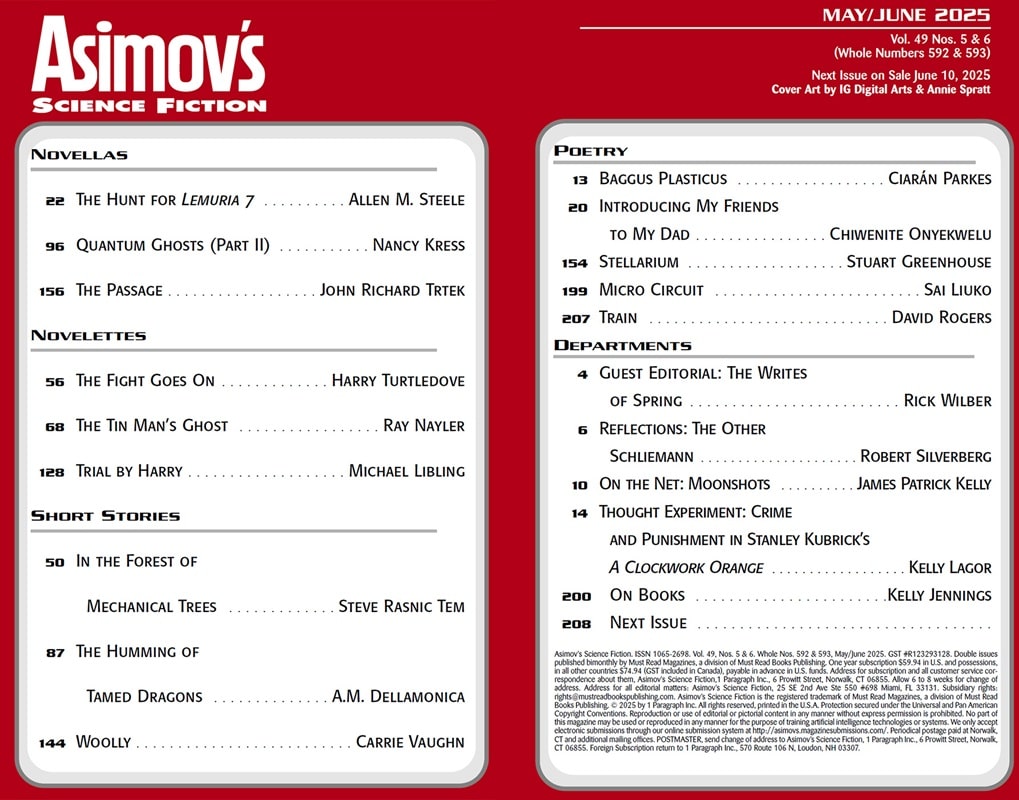
Asimov’s Science Fiction
Sheila Williams provides a handy summary of the latest issue of Asimov’s at the website.
We have three thrilling novellas crammed into our May/June 2025 issue! The issue opens with Allen M. Steele’s exciting and enigmatic “Hunt for Lemuria 7”! Allen takes us back to the Moon where the mysterious disappearance of Lemuria 7 and its crew becomes a conundrum. John Richard Trtek delivers an exquisitely told tale set on a far-future Earth where humans who wish to emigrate to an alien planet must first embark on “The Passage.” Nancy Kress wraps up the issue with the conclusion to her brilliant hard SF story about “Quantum Ghosts”! You won’t want to miss any of these exciting works.
A.M. Dellamonica squeezes a movie-length suspense/romcom film into a short story about “The Humming of Tamed Dragons”; Michael Libling spins a deceptive horror story about what it means to endure “Trial by Harry”; Carrie Vaughn conveys the heartfelt story of a woman’s attempt to rescue “Woolly”; Ray Nayler’s novelette tells the complex tale of a retired Sylvia Altstatt called back into service by “The Tin Man’s Ghost”; Steve Rasnic Tem invites us “In the Forest of Mechanical Trees” where an elderly group of people who maintain a sculpture park try to create a whimsical sense of normalcy for a family escaping the ravages of climate change; and Harry Turtledove’s time travel tale about frustrating and tragic historical events reveal why “The Fight Goes On.”
Robert Silverberg’s Reflections muses about “The Other Schliemann”; James Patrick Kelly’s On the Net takes some “Moonshots”; Kelly Jennings’s On Books looks at works by T. Kingfisher, Madeline Ashby, John Wiswell, Cebo Campbell, Michael Bérubé, and others; Kelly Lagor’s Thought Experiment considers “Crime and Punishment in Stanley Kubrick’s A Clockwork Orange”; plus we’ll have an array of poetry you’re sure to enjoy.
Here’s the complete Table of Contents.
Novellas
“The Hunt for Lemuria 7” by Allen M. Steele (Novella)
“Quantum Ghosts (Part II)” by Nancy Kress (Novella)
“The Passage” by John Richard Trtek (Novella)
Novelette
“The Fight Goes On” by Harry Turtledove (Novelette)
“The Tin Man’s Ghost” by Ray Nayler (Novelette)
“Trial by Harry” by Michael Libling (Novelette)
Short Stories
“In the Forest of Mechanical Trees” by Steve Rasnic Tem (Short story)
“The Humming of Tamed Dragons” by A.M. Dellamonica (Short story)
“Woolly” by Carrie Vaughn (Short story)
Poetry
“Baggus Plasticus” by Ciarán Parkes (Poetry)
“Introducing My Friends to My Dad” by Chiwenite Onyekwelu (Poetry)
“Stellarium” by Stuart Greenhouse (Poetry)
“Micro Circuit” by Sai Liuko (Poetry)
“Train” by David Rogers (Poetry)
Departments
Guest Editorial: The Writes of Spring by Rick Wilber
Reflections: The Other Schliemann by Robert Silverberg
On the Net: Moonshots by James Patrick Kelly
Thought Experiment: Crime and Punishment in Stanley Kubrick’s A Clockwork Orange by Kelly Lagor
On Books by Kelly Jennings
Next Issue
Analog, Asimov’s Science Fiction and The Magazine of Fantasy & Science Fiction are available wherever magazines are sold, and at various online outlets. Buy single issues and subscriptions at the links below.
Asimov’s Science Fiction (208 pages, $8.99 per issue, one year sub $47.97 in the US) — edited by Sheila Williams
Analog Science Fiction and Fact (208 pages, $8.99 per issue, one year sub $47.97 in the US) — edited by Trevor Quachri
The Magazine of Fantasy & Science Fiction (256 pages, $10.99 per issue, one year sub $65.94 in the US) — edited by Sheree Renée Thomas
The May-June issues of Asimov’s and Analog are officially on sale until June 8, but (assuming they ever show up at all) likely will be on shelves a little longer than that. See our coverage of the March-April issues here, and all our recent magazine coverage here.
John O’ Neill: ‘But the new owners don’t seem to have the myriad complexities of distribution figured out yet.’
It’s not about ‘complexities of distribution,’ primarily.
As you may have noticed, it’s 2025, and — if you live in the USA — at this point, distribution and display on magazine racks in places like Barnes & Noble, airport bookstores, and supermarkets happens because publishers *pay* serious money for space on those racks for their magazines, with the prime eye-level space going to the bigger payers.
I used to be a writer for various glossy tech-scientific-business media with international distribution, and I had occasional discussions with editorial-publishing department folks about how having a print run over a certain size, even if the mags sold, was a loss because the money they had to pay for the distribution and the store display space was increasingly too much — and that was 10-15 years ago, and everyone has just gotten more desperate and greedier since then.
To the extent that ASIMOVS and ANALOG could still be found on the bottom of the racks next to the puzzle magazines during the last few years — I left the US at the end of 2021 — was because they were part of that little publishing ecology of puzzle, crossword, and sudoku magazines which Penny Publications dominates, and the chain bookstores and supermarkets therefore won’t kill. Likewise, that F&SF got increasingly hard to find was almost certainly for the same reason — it wasn’t part of that ecology and Gordon van Gelder couldn’t pay the increasing rate for distribution/rack space.
So in the future if you want print copies of your SF magazines, you’re probably going to have to get them via subscription. At least, till the US Post Office gets privatized and that starts going away.
Hi Mark,
Interesting take. You may be right about the cost of distribution.
Curiously, getting print magazines is the primary reason I make semi-regular trips to my local B&N (since I started buying heavily on Amazon, it’s almost the only reason). But while I’m there I usually buy 2-3 new releases.
If B&N stops carrying print SF mags, everyone loses. Most especially, perhaps, the bookstore.
Thanks, John —
I’ll be interested to hear about your experiences at B&N in the coming months. SF magazines — which publish short stories and novelettes — are still the life-blood of the genre, because to a great extent that’s still where the new writers with new concepts emerge. One would like the trad mags to survive in decent shape.
Granted, a larger number of internet-based SF magazines notionally exist today than print SF mags during the 1950s SF mag boom (till the American News Company went away in 1958/59, as its building/NYC real estate was worth more than its distribution business). But they’re so unstable — even Andy Clarke at CLARKESWORLD has constant stories of struggling.
Finally, as you say, the pity of it is that ‘If B&N stops carrying print SF mags, everyone loses. Most especially, perhaps, the bookstore.’ Unfortunately, ‘America– it’s not a country, it’s a business’ applies, and everything is about the next quarterly earnings report.
John, my brother just told me he saw the current ANALOG and ASIMOV’S at a Barnes & Noble here in the San Francisco Bay Area of California!
Excellent — thanks Jeremy!
Some readers have started sending me snapshots of bookstores with the issues on the shelves. I’ll try my local B&N again this week. Fingers crossed!
I know I’ve mostly shifted from Analog/Asimov’s to periodicals such as Lightspeed, Clarkesworld and other similar digital magazines. Frankly, while A/A obviously publish good works, I prefer the more international and less traditional content the digital magazines provide. There’s only so much Steele, Turtledove and Kress et al. I need in my life although I’ve enjoyed them all. Still, I’m old enough to enjoy looking at my shelves and shelves of old subscriptions and dig through them every now and again, enjoying some random story. Digital will just never provide that for me.
Pete,
I know what you mean. Neil Clarke (editor of Clarkesworld, started printing Chinese SF a decade ago, and was instrumental in introducing some of the biggest SF writers in the world to American audiences for the first time. John Joseph Adams at Lightspeed, one of the canniest editors in the business, has an experience eye for top-notch international work.
But I still enjoy the experience of having a science fiction magazine in my hands, as I recline on my lawn on a summer day. There’s room for both outlets in the market for a few more years (I hope).
Heya John,
A good Summer read is nice but nothing beats crawling under the covers in my nice, comfy robe when it’s howling outside to enjoy a good magazine/book!